
Welcome to mariettasnakes.com! I am David, a snake enthusiast living in Marietta, GA. Many people don't know that Marietta is in fact full of snakes! You just need to know where to find them - they can often be shy and elusive. Some Georgia snake species are more common outside of the city limits, in different parts of Cobb County GA, but many types of snakes are indeed common in the more urban parts of Marietta. This guide is meant to help educate you about the beautiful snakes of Marietta, and to help you identify the most common snakes of Marietta, as well as the venomous snakes of Marietta that you should learn to recognize and avoid. If you want more detail, click here for my complete list of ALL snake species in Marietta. Remember the following:
- Most snakes of Marietta are harmless and don't want to encounter you
- Venomous snakes exist but are uncommon in Marietta, Georgia
- Snakes eat rats and mice and are a valuable part of the Georgia ecosystem
- Never kill a snake - if you leave a snake alone, it will leave you alone.
Common Snake Species in Marietta
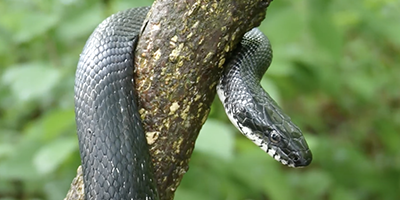 Black Rat Snake:
The black rat snake (Pantherophis obsoletus) is a bulky, massive sort of snake which may instill fear in people, despite it being non-venomous. It can grow up to 6 feet in length (or roughly 180 cm) and is considered the longest snake in all of North America. Its body, in adulthood, is colored in an unremarkable black, with a white-ish, beige underside. While it’s highly adaptable to different habitats, it prefers heavily wooded areas (it is an excellent climber) and dines on mice, rats, voles, and the like. While not an overly aggressive creature, it will attack if threatened.
Black Rat Snake:
The black rat snake (Pantherophis obsoletus) is a bulky, massive sort of snake which may instill fear in people, despite it being non-venomous. It can grow up to 6 feet in length (or roughly 180 cm) and is considered the longest snake in all of North America. Its body, in adulthood, is colored in an unremarkable black, with a white-ish, beige underside. While it’s highly adaptable to different habitats, it prefers heavily wooded areas (it is an excellent climber) and dines on mice, rats, voles, and the like. While not an overly aggressive creature, it will attack if threatened.
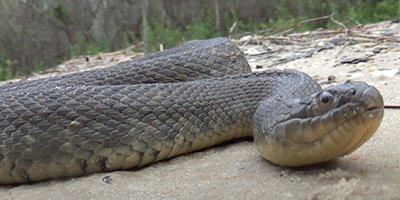 Eastern Green Watersnake:
The green watersnake (Nerodia cyclopion) is a common sort of aquatic serpent, endemic to a large chunk of the United States. The eastern green watersnake stands out through its fairly big size, with adults growing up to 55 - 60 inches (or about 140 cm). Its body is bulky and fairly big, which might make it more noticeable, in spite of its dark green, brown, or grayish colors (which make it hard to see in greenery). Interestingly, it has a yellow underside that creates a fascinating contrast with the olive green shade from above. Its eyes are marked by multiple rings. It mainly feeds on prey related to water, like fish, crayfish, or frogs.
Eastern Green Watersnake:
The green watersnake (Nerodia cyclopion) is a common sort of aquatic serpent, endemic to a large chunk of the United States. The eastern green watersnake stands out through its fairly big size, with adults growing up to 55 - 60 inches (or about 140 cm). Its body is bulky and fairly big, which might make it more noticeable, in spite of its dark green, brown, or grayish colors (which make it hard to see in greenery). Interestingly, it has a yellow underside that creates a fascinating contrast with the olive green shade from above. Its eyes are marked by multiple rings. It mainly feeds on prey related to water, like fish, crayfish, or frogs.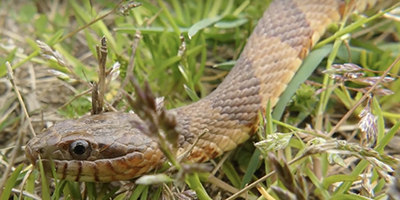 Plain-Bellied Watersnake:
The plain-bellied watersnake (Nerodia erythrogaster) is an aquatic type of non-venomous snake that prefers to live near a permanent water source, such as a lake or a pond. The snake is large, usually growing to 40 inches (120 cm), and has a thick body, with one solid color, be it gray, brown, olive green, or sometimes almost black. The lighter-colored specimens sometimes have distinctive blotches marking their backs. It usually feeds on water-based prey, such as crayfish, which it sometimes chases, but sometimes waits for.
Plain-Bellied Watersnake:
The plain-bellied watersnake (Nerodia erythrogaster) is an aquatic type of non-venomous snake that prefers to live near a permanent water source, such as a lake or a pond. The snake is large, usually growing to 40 inches (120 cm), and has a thick body, with one solid color, be it gray, brown, olive green, or sometimes almost black. The lighter-colored specimens sometimes have distinctive blotches marking their backs. It usually feeds on water-based prey, such as crayfish, which it sometimes chases, but sometimes waits for.
Venomous Snake Species in Marietta
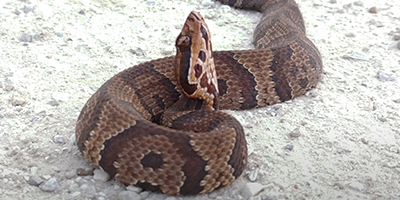 Cottonmouth:
The cottonmouth (Agkistrodon piscivorus leucostoma) is a widely popular type of venomous serpent. It is also sometimes known as the water moccasin because it can frequently be found near watery areas, such as swamps, streams, or lakes. It has a stout, grayish-brown body, and can sometimes have crossbands marking its back. It grows progressively blacker as it ages, making the crossbands difficult to spot. It’s a small-ish snake, only measuring around 27 inches (or 70 cm). It has been known to gape its mouth wide before striking, so as to threaten away predators.
Cottonmouth:
The cottonmouth (Agkistrodon piscivorus leucostoma) is a widely popular type of venomous serpent. It is also sometimes known as the water moccasin because it can frequently be found near watery areas, such as swamps, streams, or lakes. It has a stout, grayish-brown body, and can sometimes have crossbands marking its back. It grows progressively blacker as it ages, making the crossbands difficult to spot. It’s a small-ish snake, only measuring around 27 inches (or 70 cm). It has been known to gape its mouth wide before striking, so as to threaten away predators.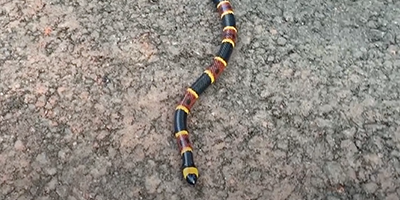 Eastern Coral Snake:
The eastern coral snake (Micrurus fulvius) is thus named because of its unusual color pattern, which usually involves an array of red and yellow circles around the body, intermingling. It’s not an overly large serpent, only growing up to around 31 inches (80 cm). While its neurotoxic venom is quite potent, the eastern coral snake does not account for many fatalities in the US, since it’s a secretive snake, reluctant to bite. Its diet consists mainly of lizards and even smaller snakes, and it prefers bushy, dry areas.
Eastern Coral Snake:
The eastern coral snake (Micrurus fulvius) is thus named because of its unusual color pattern, which usually involves an array of red and yellow circles around the body, intermingling. It’s not an overly large serpent, only growing up to around 31 inches (80 cm). While its neurotoxic venom is quite potent, the eastern coral snake does not account for many fatalities in the US, since it’s a secretive snake, reluctant to bite. Its diet consists mainly of lizards and even smaller snakes, and it prefers bushy, dry areas.
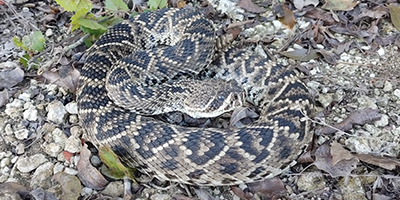 Eastern Diamondback Rattlesnake:
The eastern diamondback rattlesnake (Crotalus adamanteus) is a type of pit viper, and as such, a venomous serpent. It measures in size roughly 6-8 feet (or up to 2.4 m), which is quite big for a snake. It has a fairly hefty body, colored in a lighter brown base color, distinctly marked by darker (sometimes black) diamonds, hence its name. It can usually be found in forestry areas or pine woods, where it has easy access to a wide range of small mammals to feast upon. It is a bold snake that will stand its ground and strike if threatened.
Eastern Diamondback Rattlesnake:
The eastern diamondback rattlesnake (Crotalus adamanteus) is a type of pit viper, and as such, a venomous serpent. It measures in size roughly 6-8 feet (or up to 2.4 m), which is quite big for a snake. It has a fairly hefty body, colored in a lighter brown base color, distinctly marked by darker (sometimes black) diamonds, hence its name. It can usually be found in forestry areas or pine woods, where it has easy access to a wide range of small mammals to feast upon. It is a bold snake that will stand its ground and strike if threatened.If you're unsure, you can email me a photo of the snake at info@mariettasnakes.com and I will email you back with the snake's species. If you found a snake skin, read my Found a Skin? page, and you can email me a photo of the skin, and I'll identify the snake for you. If you need professional Marietta snake removal help, click my Get Help page, or see the below website sponsor I found, who provides that service.
Remember, the term is not poisonous snakes of Marietta, it's venomous snakes of Marietta. Poison is generally something you eat, and venom is injected into you. That said, dangerous snakes are very rare in Marietta. The few venomous snakes of Cobb County are rarely seen. But they are commonly misidentified, so learn about all the snake species of Marietta in order to correctly identify them. These snakes are usually also found in the surrounding towns of Smyrna, Powder Springs, Mableton, Vinings, Fair Oaks and the surrounding areas.
Read our article about:
How to Get the Snake Out of the Pool
mariettasnakes.com domain and hosting costs made possible by the generous support of this sponsor:
